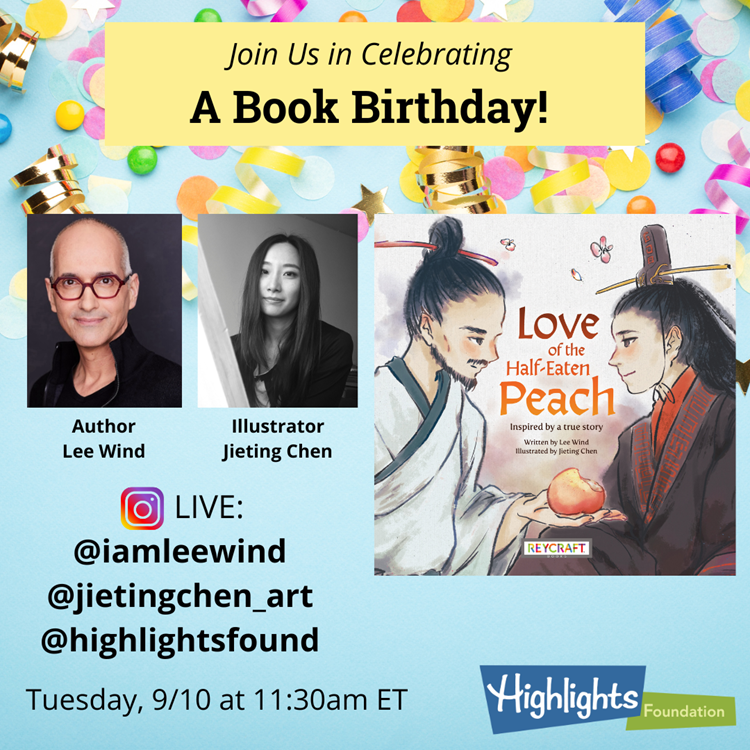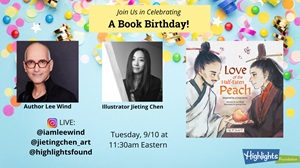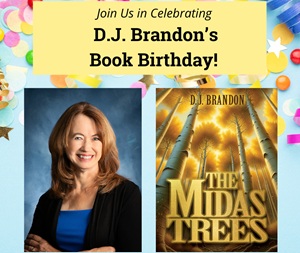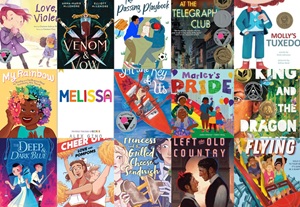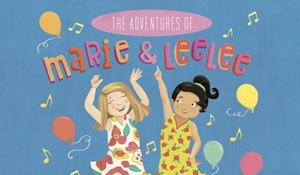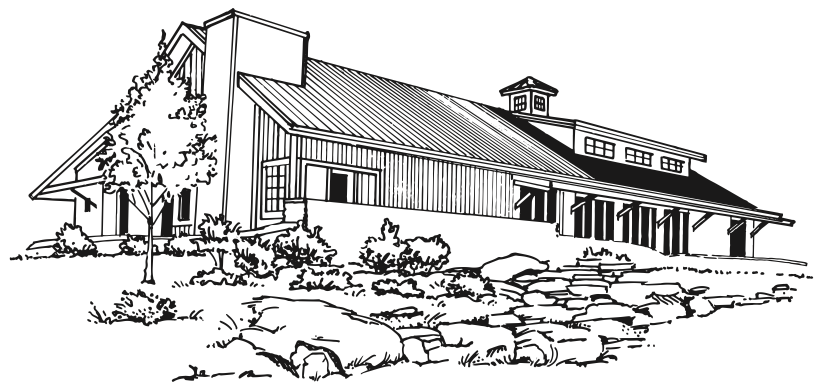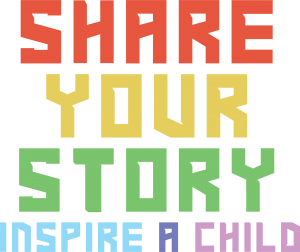Social Media Manager Cat Galeano celebrated the book birthday of new picture book Love of the Half-Eaten Peach with author Lee Wind and illustrator Jieting Chen. It was a moving conversation celebrating Happily Ever After queer stories old and new.
Watch the conversation or read the full transcript below. (Please note: closed captions are being added to the video below. When they are finished, you can see them by hovering over the bottom of the video and choosing the “CC” icon.)
Full Transcript:
Cat:
So I am so excited to get started. Are you ready?
Jieting:
Yay…yes.
Lee:
Yay. It’s a party now.
Cat:
It’s a true party now. We are in celebration mode. Um, so let me get started.
A big hello to our Highlights Foundation family. We’re so happy to have you here with us today.
We love celebrating, and I’m so happy to have these two wonderful people with us.
Uh, for those that may not know me, I am Cat Galeano, my pronouns are she/her and I am the social media manager here at the Highlights Foundation, also known at the Person Resharing Your Post and responding to your post with the blue and green hearts. This is the human behind all of that.
I’m joining you from Westchester, New York on the traditional lands of the Seewanoy people.
And apart from all the very fun things I get to do at the Highlights Foundation, one of my greatest joys is celebrating the book birthdays of our community members, faculty and friends, because all of your wins are our wins.
And today I have the honor of celebrating the beautiful new picture book, Love of the Half-Eaten Peach, written by our friend Lee Wind and illustrated by Jieting Chen.
And we’re so excited to have you. But before we dive into our questions, I just want to remind our viewers that joining in on any Highlights Foundation spaces to do so, please, with no hate, no harm, and no harassment of any kind.
Now, let’s celebrate! Now let’s get into the fun stuff. Um, so my first question is, is for you, Lee, um, why this story? Why was it so important to tell, and to tell it with Jieting Chen?
Lee:
Yeah, Thank you. Um, first of all, thank you to Highlights. Thank you, Cat.
I’m really excited. Um, this is, for Jieting and I, this is really our launch, right? Yeah. Like the book came out last, last week, but this is really, this feels like yes: now the book is out in the world.
Um, so I am gay, and I was closeted between 11 and 25, and I didn’t know anybody else was gay in the history of the world, ever. I thought I was the only guy that liked, liked other guys. And, um, there’s a huge weight to that.
And, you know, I think it’s hard for kids today to think that they’re, um, you know, we, we know that there are queer people today, which is very, very cool and exciting. But there’s still this sort of false facade on history that, that queerness didn’t exist in history.
So, um, back in 2006, I went to, uh, talk and, um, this guy was talking about the, the letters between Abraham Lincoln and Joshua Fry Speed that convinced him that Abraham was in love with Joshua. P.S. I think Abraham was in love with Joshua–there’s actually a movie out now, Lover of Men…
Um, but I got really into it and I started to do all this research about queer history and men who love men and women who love women, people who love, loved without regard to gender, and then also people who lived outside sort of the boundaries of gender.
And, um, in doing that research, I came upon this story, the, the, the, the true story that inspired Love of the Half-Eaten Peach.
And, um, when I published No Way They Were Gay With Lerner, um, one of the, one of the, um, sidebars was, uh, was this, and if, if, if you, with your indulgence, I’m going to read it.
Um, how do you say gay: more than 2,500 years ago in what is now China, the ruler of the state of Wei, Duke Ling, was walking through an orchard with the man he loved, Mi Zi Xia, picked a ripe peach from a tree and started to eat it. It was so delicious that after a few bites, Mi Zi Xia gave the rest of the peach to the Duke so he could share it.
The Duke was moved by this and said, how sincere is your love for me? You forget your own appetite and think only of giving me good things to eat.
Later, as the philosopher Han Feizi tells us, in his book of essays, written sometime between two 60 and two 30 BCE the Duke fell out of love with Mi Zi Xia and accused him of committing a crime,
After all, said the ruler, listing the reasons not to trust his former love,
another time he gave me a half-eaten peach to eat. Duke Ling’s fickle nature aside, the sharing of the peach and the symbolism of the love behind that sharing became famous.
So famous that in Chinese the expression “love of the half-eaten peach” was used for over a thousand years, as we use the word “gay” in English, to describe two men in love.
I could not get that idea out of my mind, and somebody in my life said to me, you know, that would make a cool picture book.
And I really struggled with it because like, it’s a adult love story. Mm-Hmm. So how is that a picture book for kids? Um, and I, oh gosh, I, I, there was, it was such a long process to, to do it, but, but the, the heart of it was what captured my imagination so much, right? like, um, like how could I tell this story in a way that would resonate for kids and also be this celebration, this sort of like epic celebration of queer love.
Um, so that was why it was so important to tell it.
And, and when, and I, when the manuscript sold to Reycraft, we talked about illustrators and I said, look, I mean, I can vouch for the, for the queer part of history on this, right? I’m queer, I can do that. But like, we absolutely need to find an amazing illustrator that has some Chinese heritage, some Chinese knowledge, because like that part of it, I can’t bring to the story, but that’s what it needs.
And then amazingly enough, I don’t, Jieting, I don’t know how they found you, how that connection happened, but it, it’s magic. And the the art is just sumptuous and incredible and has that sort of, ah, you, it’s just, I I, I didn’t have words for how excited I am, and I’m a word guy.
Um, so, uh, so yeah, so I feel like, you know, the, the, the words are like the story. I think a picture book’s a lot like, um, like a billboard, right?Like, like there’s, when you go on the–I live in Los Angeles, there are a lot of freeways–so like, there’s all these billboards on the side of the road, right? And like, there’s this structure, there’s like steel, wood that’s holding the billboard up, and then there’s this very pretty sort of like, you know, ad that goes on top of it.
Um, so I think like the words are like the structure in a lot of ways. Um, and like, like the, there’s the story structure and then there’s the words, but that’s only half of it. And then the other half is what the illustrator brings to it.
And they have their own visual structure and their own style and their own narrative that they add to it. And it just, it’s not like, I mean, Jieting and I did not talk at all in the, in the creation while, while Jieting was working on it.
It was, it was her story, but it became our story. And that’s what’s like, the most magical moment as an, as a, as a, as a writer of an illustrated manuscript is when you see the art and you’re like, oh my gosh,
Cat:
Listen, I, I, I, I don’t wanna jump the gun too much because like, our, my question about the art is coming. But I do wanna tell everybody, if you see this in the bookstore, please, please, please run and grab it and open it, because the art, Jieting, your art just like elevated me to places: it took Lee’s words and just truly made it soar. Like it was one of those books where you look at it and you’re like, wow, I want a print of this in my house. Like, it is just so beautiful. And please people run and grab it.
Um, but also a big shout out to Reycraft for publishing this book, because like you mentioned, Lee, like this is a story that’s been around for millenniums, really, and the fact that you found it and you were like, I need to make this happen, and you championed it, and Reycraft was like, yeah, let’s do it. Like, it is so important to know that love stories like this exist way, way, way beyond our imaginations in times that we don’t even think about anymore. So the fact that this exists and that it lives out there and these people’s story, I mean, it is just, ah, it was just a delightful to read.
Anyway, let me jump to my next question because I could send you all the flowers forever. So let me jump in, jump into my second question, which Lee kind of touched upon a little bit.
But, um, we do know that you’re a prolific researcher, which is essentially how you, this story came to you. You write nonfiction and fiction and this story weaves together history and legend and lyricism and so many beautiful things. Um, what did your research and writing process look like?
Lee:
So, I, I figured out, I found this story, I don’t know, like I started playing with it, the idea of it being a picture book in 2015, in the summer of 2015. Right now, just for those watching this in the recording it is like, you know, just the end of summer 2024.
So there you go, nine years from, from idea of, “Ooh, this is going to be a picture book” to, like, actual picture book published.
Um, I don’t know that, you know, your results may vary, but like, um, so I feel like for me, I, I wanna write picture books that are sort of, I tend to write picture books that are sort of like inspired by history, by inspired by true stories, but I’m not writing nonfiction picture books.
Mm-Hmm. Um, and for me, that’s a huge pivot because like, if I just wanted to tell the story of them walking through the orchard, the one I read, right Like, and like, then it’s sort of like, it’s sort of sad, right? Like they fell out of love. Like, ugh, that’s a bummer. Like, that’s not, that’s not what’s exciting to me about this story. What’s exciting to me about this story is that that moment of love, like for a thousand years, that’s how they said “gay” in Chinese. Like, that was what was exciting to me.
So I was like, well, how do I capture that? And then I was like, so I kind of like, I do all the research and then I kind of put it aside or like in the back of my mind, and I’m like, how is this a story? How is this a story about kids? Mm-Hmm. And then that was the whole idea about perfection and about like, what is perfect and how can you know if, if, if this, if if we meet them as children and they’re friends and they grow to be teens and young adults and they fall and, and, and they’re sort of falling in love on that journey, then it’s like there’s a way in for kids.
And this idea of like, you know, enjoying something and wanting to share it with someone you care about, like, I think that feels very universal and also very kid friendly. Mm-Hmm. But kids are aware of romantic love. So the fact that it was romantic love felt really important. And yet not to like impose my, like, I had a lot of drafts where like, there was a big romantic kiss in the end, and I was like, that was in the art notes.
And it’s like, it didn’t need the big romantic kiss. And also that wasn’t my, I didn’t need to force that as the, as the author.
There were so many versions. I have a huge folder here, um, of all the different versions of, uh, of the manuscript.
And, you know, it’s not that many words, uh, but I think that for me, it was like pulling back from the real thing, from the real story and creating a structure, creating this idea that like, okay, he’s challenged that like the, the, the ruler, the future ruler of Wei is, is one, is being challenged.
You have to understand perfection if you’re going to be a successful ruler. And then that becomes the, the through line that becomes the sort of the spine of the story that like, they’re trying to find something perfect so he can understand it and then eventually be a good ruler.
And that becomes the, the peach and then the twist at the end. I was very excited about when I figured it out. And, um, yeah. And then it was sort of like, it was this huge, I kept revising and revising and revising and back and forth with my agent about like, well, it’s a, you know, how does this work for kids? And then kind of felt like I had it figured out by 2019.
Um, like, you know, I, I have a full-time job, so it’s not like I’m working on this full-time and I’m working on other projects too. But like, I felt like by 2019 I had a version that was like, okay. And then, um, and, and could work.
And we had a couple of close calls with other, with other publishers, but it ended up being Highlights that was the breakthrough.
And I will pause there, we’ll pause there as a teaser.
Cat:
That’s another question. But I guess my question is for Jieting, when did you officially come onto this project?
Jieting:
Uh, I think it was early 21, 22, I think. Yeah. Reycraft, uh, reached out to me and sai, “Hey, this is a really good story and you came from this background and are you interested?”
And I read the book and I was like, oh, I have, I have to be in this story. Yeah, I’m, I’m very honored that they chose me and I’m happy to be in Lee’s story. And now it’s our story. And I’m really glad, I’m honored to be in this book.
Cat:
I think both, both of you also touched upon a really interesting thing, which we forget, you know, when, you know, we’re all in celebration mode, the book is out and like, yay. But like, the time and effort that goes behind it to get to this point,, like the fact Lee, that you shared that it took nine years, you just showed your drafts and like the revisions and revisions, and then at what point was Jieting invited to be part of the project? Like, those points I feel like are so important to talk about when we’re in celebratory book mode because, you know, it’s amazing to have the final product, but like, it’s so much more amazing to know the gargantuan effort it took to get there.
So I love that you shared those bits and pieces and, um, now we’re gonna go right into the art,’cause I’ve been waiting to talk about the art. Um, the art is just insanely gorgeous and it took Lee’s words and just elevated it to a place I think that this story deserved.
Um, I think it’s watercolor. I am not an artist myself, but I think it might be watercoloring. Jieting, talk to us about everything that went into making this book: the process, illustrations. How, just tell me, I, I’m ready. I’m ready,’cause let me tell you, I was just, I read this book multiple times and I was like, oh, these words, these art, oh my God, I’m, I’m singing myself.
Jieting:
All right, thank you. Thank you so much, and I’m really glad you like it.
Actually, I’m really glad you asked because it is not watercolor, it’s all digital.
Cat:
No way.
Jieting:
Thank you. It took a lot of effort for me for years to mimic this watercolor in, um, Photoshop. And, uh, the way I finally did is I, um, have a really thin layer of the base, a really light color, and then I use a, use a smart tool and lay out a dark color on top so that it really mimics the watercolor quality and it has this flow.
And then I have a scan of a lot of, uh, rice paper that we usually do traditional Chinese painting on, and I lay that on top in the final. And, uh, that’s what you see in the end. And I’m really glad it can trick somebody to think it’s watercolor. Yeah. It does take a lot, lot of effort.
Cat:
So like, how long was that process then? Because in my head I’m like, it’s, it’s just one medium, but now I’m hearing it’s like definitely multilayered.
Jieting:
Yes. Yeah. I mean, um, it does not really take a long time once you get used to it, but I think the organic-ness of the brush stroke, that’s the hard part part for me that, uh, I really want to make it as authentic as possible.
So, uh, the process, the learning curve for me, it is really the hardest time for me. And I’m really glad it came through. And you all like it.
Cat:
I mean, the fact that it’s not watercoloring is legitimately blowing my mind. I was like, I could talk to you for another 20 minutes just being like, tell me more.
Lee:
Well, and then can I ask a question of Jieting? So, so there’s also this crazy quality of light that you, like, when you go through it. You know how some picture books, there’s like, there’s like a, a little duck that appears in each spread and you’re like, oh, follow the duck in this book.
It’s like the quality of light that Jieting has added, the, the hidden rainbows, the flashes of gold, and, uh, just, it’s so amazing. So was that like a whole other, like pass through the illustrations?
Jieting:
Well, actually, because I came from a animation back, uh, background, so the rhythm of the book really was, uh, always in my mind. Like when you read this book, how you pause in each page and how, how your eye vision really flows in each page, that really, uh, is my main concern.
Like, I really used the light to lead the viewer’s, uh, eyesight in each page. So it really, I designed it so that, you know, the kids really pauses and ooh, from this page and then it flows to the next.
I think that’s, that’s my, uh, design and I, I’m really glad it shows. And Lee, you noticed it. I’m really happy.
Lee:
Wait, and I just have to, I have to, I have to, like, we, we just, I just have to share this one thing that Jieting did that every time I see it blows my mind. So this is a spread. I know it’s hard to see ’cause I’m vertical, but this is a spread of like a real pivotal moment in the story where, um, you know, uh, Mi Zi Xia thinks he solved the riddle, but Yuan says no, it wasn’t what he thought. And so it’s this very disorienting moment.
So look how brilliant this is. Yuan is on this side and, um, Zi Xia is on this side, and then there’s this in inter, in-between thing of the flowers and the text. And then they flip, they flip positions. Now Yuan is on this side and Zi Xia is on this Z is on this side.
That is so brilliant.
Jieting:
Yeah, it’s like the position the camera, Right, right.
Lee:
It’s like, it’s like the viewer, the viewer has gone like this around the two main characters and it’s so disorient, it’s visually disorienting at the moment that the text is revealing that the character is disoriented.
It is flipping brilliant. I just, I was so excited.
Cat:
I am so blown away right now. I didn’t even realize that until you pointed it out. And now I’m like, literally, it’s like a, it’s like the, the audience is stepping out and looking in because it just did like a whole swirl around. Oh my God, this book.
Jieting:
And also, I know we’re in time limits and I really want to, uh, talk about this spread because in this whole book, all art are the full spreads, right?
Yes. This is the only spread that we split, split in three. And this is the spread I really want to change the pace of the reader. It’s like a comic book. Yes. Like you really read fast, like the pass of time. So this is the only spread I split them in three and, uh, it really changed the pace and changed how the viewers view the, uh, the story.
And, uh, it kind of fast-ened the time and also pause the, the time at the same time. So, um, I really want to talk about that. Yeah. And I’m really happy, Lee, you brought up.
Lee:
Which was brilliant because it was, that was the pivot moment of the story.
Like that was right before the climactic twist. And so it was, it was like a visual twist in addition to the story twist and the text twist. So yeah, it was amazing.
Cat:
I cannot wait to go back and read it because that, like, you’re so right now
that I think about it, it’s like it was such a pivotal scene and it really forced the reader, reader to pause because then it was like a boom, boom, boom. And you’re just like, what’s gonna happen next? So it really just like amped up the pacing.
I know somebody asked that they wanna see the cover of the book. I have it on my computer. I don’t know how well you’ll be able to see it, but yeah. So it is, hopefully that helps. Yeah, hopefully that helps so you can order it.
Um, thank you so much for talking about that. I, Oh my gosh. Yeah. And I feel like you did something so creative with that three, like, almost like comic panel style. I’m like, maybe someone, maybe others will, will be inspired to, to try that, ’cause that was so cool. Like, it was just all beautiful and like, you know, the spreads and then all of a sudden it was just like getting to that hyper climax moment. You’re like, oh my God. And then the art matches it.
Oh my God. So cool. Thank you. So cool. Um, I feel like I have to get to my next question because we could just talk forever and you know what, I would love that, but not everybody has all the time in the world.
But, um, so my next question is, um, Lee, can you talk about your journey, um, and how the Highlights Foundation has played a part of it? And, and kind of like a add-on to that question is Jieting, I know we have not welcomed you to our campus yet, but you are officially part of our Highlights Foundation family, so we cannot wait to see you online or to see you on campus.
But Lee, talk to us about how the Highlights Foundation has been a part of your journey.
Lee:
Yeah, so I mean, my first picture book that got published wasn’t, uh, it was with, uh, Levine Querido and it was called a Red and Green and Blue and White. And I was very proud of it, but it wasn’t queer. And I’m, you know, I, I run a, I’m, I’m very queer and I run a blog called I’m Here, I’m Queer, What the hell Do I Read? And I’ve been doing that for good, gosh, like 19 years.
Um, and I really wanted, uh, to have one of my picture books that has queer content get published and, you know, and I thought this would be the oneL Love of the Half-Eaten Peach. I just was really, I don’t generally write in this sort of like, very lyrical way, but for some reason that’s how this story wanted to be told.
Mm-Hmm. Um, so I wasn’t really sure what to do with it. Like, it, by 2019, I felt like I had it figured out. We’d had two close calls with, with, um, different editorial, with different publishers, but for one reason or another it didn’t work out. And I was like, oh, I felt sort of stuck.
And then, um, I, in 2021 Highlights announced that they were going to do a Reading The Rainbow Mm-Hmm, uh, sorry, Writing the Rainbow Picture Book queer, uh, virtual class. And it was like the pandemic. And I was like, virtual, I can do that. And, um, I signed up for it and it was, it was, um, uh, taught by Rob Sanders and Lesl a Newman. And uh, and they had brought,
they had brought in different guest editors, and one of the guest editors was Wiley, uh, Blevins from Reycraft.
And I was like, huh. And he, you know, he talked about like what he was looking for, and I was like, ah. So right after the class ended, I mean,
I don’t even know if the class actually ended. It may have been literally like that night after, like going to the session that he was in, I emailed my agent and I was like, please submit.
And I mean, so that was the summer of 2021, and then we got the offer in November of 2021. So Jieting, you must have been contacted early in 2022.
Jieting:
Yeah.
Lee:
And, and you know, and that was just kind of magical. I mean, that’s actually pretty fast. Like in terms of like how publishing is weird…
Cat:
It’s like how publishing works.
Lee:
It’s like, it’s so incredibly glacial and then it’s like panic, Right? That’s a joke. There’s two speeds, glacial and panic. Um, but, uh, I, it’s just, it’s so exciting how it all came together. And so yeah. Highlights is, I mean, Highlights is the good. This is a Highlight success story because, you know, it’s, it’s, it’s not the main story I worked on in that session because I shared it with the group, but they were kind of like, yeah, it it’s kind of ready.
Yeah. Uh, and then I kind of worked on other manuscripts in that session, but, um, you know, picture books are tricky. Uh, trying to, like, it’s, I think about it like, um, it’s like you’re apu it’s a puzzle. You’re trying to figure out like, how do I tell this story in like 500 words or less? How do I tell it and have it be, have it have all the ingredients it needs, including space for the illustrator to bring in all of their brilliance and, um, and, and really make a story that’s going to like, be more than the sum of its parts, right. Like, that’s going to, and so, yeah, I was really, I’m so excited. It’s such a beautiful book.
Cat:
It’s such a, a beautiful book and thank you for sharing that.And, and this is why I love celebrating these book birthdays. And this is something that I champion at Highlights and I said, I really, really want to do this. And my background is a, is I was a journalist, so I love talking to people. And, um, and so I really champion the opportunity to talk to our friends, faculty, community members, because their wins are our wins.
And like hearing something like this where you took this class because it was the pandemic and you already had this story, but then you took this class and then it led you to your editor who then, you know, all of this brought us here. And I’m like, this is exactly why I love to do this. This is why I wanna talk to talk to our friends and,and celebrate their wins.
Because that’s how it is. It’s, it’s why we’re here. It’s, we’re here to all make books for children and get them out there and, and we need to celebrate the wins because the lows are also low. So I love celebrating the wins. Agreed.
Um, and now I’m gonna do my final question, which I’m already sad. We’re coming to the end, um, to both of you of course: How are you feeling now that this book is out in the world and what do you hope kids take from it?
Jieting:
Me? Oh, me first. Okay. I really want to take this chance to thank you, Lee, for, uh, bringing this life, uh, story to life. Because like you mentioned, it’s one of the earliest Chinese gay stories in the history. I think it stated back to 504 BC so over 2000 years.
And you wrote this in such a poetic and historical way, and it’s easy for kids to read. And thanks for having me in this story. Like it is, uh, I came from this background and I am really happy to see my culture, my, the earliest gay story in my culture, uh, be written in another language.
And so thank you so much and thank you, uh, Highlights to having me in this celebration. And I’m really, really happy.
And I believe this book is a great addition to any bookshelf to help the kids love this world a little bit more and, uh, understand themselves and to know that this kind and form of love exists from a long, long, long, long before.
Cat:
Incredible. Thank you.
Lee:
I have, um, I have one more secret, not secret. I have one more, one more thing I want to share that, that you might not catch on first glance. So one of the things I’m most excited about, about the book is sort of, there’s a, there’s a meta story, uh, above the story of the book. So the book is about right, 2,500 years ago, the love story between, you know, um, Yuan Ling of We and Mi Zi Xia but there’s a, there’s another kind of meta love story that is on the dedication page.
And so I wrote, uh, Jieting, you get ready ’cause you’re gonna have to read your dedication here in a second.
Lee:
Okay. So I dedicated the book. So this is the, this is the, the half title page, right? And then this is the, the dedication.
I wrote it for my husband, I wrote: for Mark and the Happily Ever After we created together.
And then Jieting, you share yours.
Jieting:
Here is mine, mine is: to my beautiful wife, your unwavering love and support have been my greatest inspiration.
Cat:
Oh I have, have goosebumps.
Lee:
So, so for me, that is one of the things I love most about the book. That it’s not just that: look in history, we have queer, queer role models of love. It’s that we, the creators of this book, we each have our own Happily Ever After queer stories too, which I think tells readers you can have your Happily Ever After queer love story too. And I think for me, that’s everything.
If, if I could have read this book, if this book would’ve been read
to me when I was six years old, oh my gosh, how my life would be different. And, um, I’m just so excited to pay it forward and imagining all the young kids with their supportive adults, uh, you know, reading this and sharing it.
And I don’t think that your, your kid has to be queer for them to love it. I mean, good God, how many straight love stories have I sat through, right? Like, but I figured like we needed, we needed our epic sort of like, what’s our Cinderella, right? Like what’s our queer epic love story? And the fact that it’s based on a true story from history, it makes it just all that much sweeter.
Cat:
And I love that you mentioned thank you for, for, for, for reading your dedication pages because then it just adds, like you said, another layer because granted, this story is based in BC Times, but the fact that the dedication is from current times, from it just from the current creators of the story, it’s just what a full circle, beautiful moment in celebration of love. nd I can’t thank you for sharing that.
And that is so special to know that the creators beind them are also celebrating their own love. o it is, it is just a beautiful book, full of love, full f colors, full of lyricism, nd, um, it really needs to be on all your shelves ecause it is just a celebration of all good things that can happen when we allow good things to happen
So, um, that is my final question. I’m gonna go through to see if anyone is, wrote anything, um,
Lee:
After, and while you’re doing that, Cat, I’ll just add that for, for those watching. Um, it’s great if you can buy the book, but if you can’t afford to, that’s okay too. If you request it from your local library, that actually makes a huge difference because, um, libraries are great places for people to discover books and, um, also, you know, doing a review online, word of mouth, that’s actually really how books sell is when you tell someone, oh my gosh, I came upon this amazing book. So, um, there’s lots of ways to help.
Cat:
That is absolutely true. And, and if you can’t, can’t right now, get it, um,
maybe you’ll get it at one of the big sales, but also make sure you, um, request a real local library and all of those things and reviews and you know, things that help amplify the book.
I do have a question that asked if we, you can, um, if somebody can get a signed copy, if that’s possible, if you’re working with any indies, um, to please let us know, um, or if it’s on your website, just let us know how we can get a signed copy.
Lee:
Yeah, absolutely. Um, Pages, uh, the, uh, in Manhattan Beach, which is my local bookstore that they have, they’ll have signed copies and we can also personalize it. If you, when you order it online, you can just put it in the notes field. Yeah,
Jieting:
Okay. We’re working on that. Yeah.
Cat:
Okay, perfect. So just if, um, that in, so Pages in Manhattan Beach, I’ll make sure to put that in our blog version of our conversation. And then Jieting, whichever one, just email me and we’ll update the blog when you have that information.
Jieting:
Absolutely. And, also, I, I want to add one final thing Yes? Maybe before the end of this conversation. And, uh, because it’s a really famous phrase: “Yu Tao Zhi Pi.” Uh, it’s the saying of, uh, “love of the half-eaten peach” in Chinese, and I really want to share this with you, and if you want to learn it, it’s “Yu,” “yu” means the, the rest, like the rest of the peach.
“Tao” means peach. “Zhi Pi” means, uh, the habit of, and the love of. So “Yu Tao Zhi Pi” actually is the Chinese of this title of the book.
Cat:
It is like, the fact that that’s like what people said for in terms of, of, of the use of the word “gay” is just so incredible to me. First of all, it’s so lyrical, so beautiful.
Lee:
Thousands of years. Over a thousand years. Yes. Over a thousand years.
Cat:
I mean, like, how amazing, and thank you for also mentioning the, the, the,
the original phrase.
I really appreciate that. ’cause I certainly would, would, it would not sound as beautiful if I tried. So thank you. Thank you.
Just final going through, there’s just lots of love in the comments, so I don’t see any other questions except for the one about where we can get a signed copy. Um, yeah. And so that means I’m gonna wrap it up here because this has been such a delight.
I can’t thank you both so much for, for reaching out, for joining us today, for allowing us to celebrate your beautiful book.
And, um, of course, if you’d like to order a copy, not signed, we welcome you to, um, grab a copy through our virtual bookshop powered by bookshop.org.
Um, so thank you, thank you, thank you. Thank you Lee. Thank you, Jieting.
What a beautiful conversation for a beautiful story.
I’m gonna add in, right? The heart’s right there with you.
Lee:
We should all do it. Let’s all redo it. (All 3 make hearts with their hands!)
And then someone take a screenshot and send it to me.
Cat:
Molly, will you take a screenshot?
Lee:
Awesome.
Cat:
Thank you. Thank you both. Have a wonderful day. Everyone run and get a copy of this book, order it from, order at the library, run off and review it. It is just delightful.
I am honored to have been able to speak with both of you. And thank you everyone for joining us. We’re so happy.
And for those of you that couldn’t join us, you’ll just re-watch this at, at your time.
So thank you. Thank you.
Lee:
Thanks, Cat. Thank you everyone at Highlights.
Cat:
Bye everyone. Bye.
